Rice terraces are paddies fields made on sloping land that follow the natural contour lines. Suited to the Japanese geography, they are ideal for sustainable agriculture, having the ability to filter water and nurture organisms, among other benefits. Today rice terraces are also growing into a focus of green tourism.
History and Benefits
Rice terraces are commonly seen in hilly and mountainous areas, which are defined under the Food, Agriculture, and Rural Areas Basic Act as "areas with poor geographical conditions and disadvantages to agricultural production."
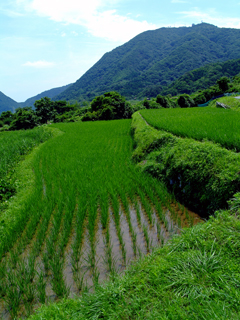
Throughout history, rice has played a significant part in the lives of the Japanese. Tanada, the Japanese word for rice terraces, first appears in historic documents dating from the early Muromachi period (fourteenth to sixteenth centuries). That the ancient Japanese made rice fields on slopes, where tilling was harder than on level land, is a testament to the supreme status of rice. Rice was the most valuable of all cash crops. Under Toyotomi Hideyoshi, who unified Japan in the sixteenth century, all agricultural products came to be listed in land registers in units of rice. This made way for the kokudaka system that developed during the 300-year reign of the Tokugawa shogunate, in which land value was expressed in koku, a unit based on rice output.
Given the importance of rice, the Japanese went to great pains to perfect the tanada so that they could turn slopes into paddies and grow rice even in adverse environments. Today rice terraces are recognized for the following multiple, far-reaching benefits.
• Water retention and flood adjustment: The terraces function as dams by holding rainwater, which slowly seeps underground and gently flows into the rivers without flooding them. At the same time, the terraces serve as filters that purify the water.
• Landslide prevention: Many rice terraces are located in landslide-prone areas. This may be due to the fact that slopes resulting from landslides retain water well and thus are relatively easy to till. Regular maintenance of the land surface through its use as rice fields leads to landslide prevention.
• Ecosystem conservation: Rice terraces support slow, natural circulation in the ecosystem, cycling the water held by the nearby forests and woods and nurturing organisms that make their home in that water, such as frogs and insects.
• Scenic value: The landscape of rice terraces is a work of art created by humans for the purpose of producing food. The terraces blend in with the natural scenery and give viewers a great sense of peace and comfort.
From Shortage to Surplus
Over the last several decades, rice has rapidly grown into an overabundant and unprofitable crop for the first time in history.
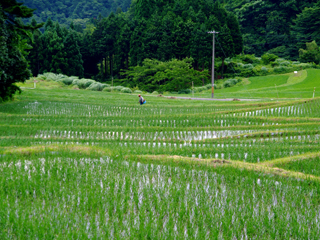
Japan was obliged to import rice in the period immediately after World War II, when food was scarce, and the government promoted rice cultivation. It undertook major land improvement projects across Japan, in which small, inefficient rice paddies were consolidated to enable large-scale cultivation. Rice yields surged with the development of improved varieties, upgrading of agricultural techniques, and mechanization. In 1968 the manufacture of mechanical cultivators peaked, and rice output also reached a record high of 14.45 million tons. This was more rice than the nation could consume, and surplus rice became a serious issue. Thus, in 1970, the government introduced a new policy, this time of reducing rice acreage.
The issue of surplus rice owes itself not only to agricultural circumstances but also in large part to the Westernization of the Japanese diet, which has drastically brought down rice consumption. Annual per capita consumption of rice today is 62 kilograms, compared with 120 kilograms in the 1960s. The annual production volume has nearly halved as well, to about 8.55 million tons in 2006. By contrast, consumption of flour has grown from around 4.80 million tons in the 1960s to around 6.30 million tons by 2004. It is coming to share the position of national staple with rice.
But given the growing prominence of metabolic syndrome resulting from a Westernized diet and overeating, the Japanese diet—at the foundation of which is rice—deserves a new look. Rice has underpinned the Japanese diet not only as the staple food but also as an ingredient for making such seasonings as miso and vinegar. Rice and soybeans, the two most basic foodstuffs of Japan, have together supported the health of the Japanese people, who traditionally ate very little meat. Although neither contains all of the essential amino acids in sufficient amounts, as animal proteins do, the Japanese were able to take in the complete set of essential amino acids by combining the two.
Rice Terraces Abandoned
Rice terraces are also coming to a crossroads. With 67 percent of farmers being 60 years old and above, more and more farmlands are lying uncultivated. According to the 2007 Annual Report on Food, Agriculture, and Rural Areas in Japan of the Ministry of Agriculture, Forestry, and Fisheries, abandoned plots have increased from 6 percent of all farmlands in 1995 to 10 percent in 2005. This amounts to 386,000 hectares, which is 1.8 times the area of Tokyo. In hilly and mountainous areas 208,000 hectares, or half of the total abandoned area, have fallen into disuse. Of particular note is the Chugoku region, which has the highest concentration of rice terraces in Japan. Farmlands here are being abandoned here at an alarming rate, suggesting that maintaining rice terraces is quickly becoming difficult. The mechanization of rice production has put rice terraces at a pronounced disadvantage over flat rice paddies, and rice terraces are evidently first in line to be abandoned.
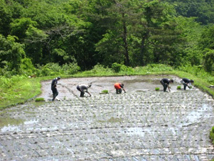
(Photo courtesy of Iio Jozo)
Meanwhile, there are those who insist on growing rice in rice terraces. One of them is Iio Jozo, a vinegar manufacturer based in Miyazu, Kyoto Prefecture. Since 1964 the rice that the family company uses to make vinegar has been organically grown in rice terraces mainly located in the mountainous Seya district. This was initiated by Terunosuke Iio, the previous owner and father of the current owner, who questioned the effects of pesticides on human health and on the paddy field ecosystem.
An age of spectacular economic growth had just begun. Pesticides had become indispensable for mass production of rice, mechanization was getting under way, and agricultural land improvement projects were proceeding at a dizzying pace. While many farms switched to large-scale production, Terunosuke resisted the trend. It was his conviction that good vinegar can only be made from good rice, and he went from farm to farm seeking their cooperation in producing organic rice. Terunosuke preferred rice terraces over flat paddies because they are free from the effect of pesticides used in neighboring fields and the risk of sewage contamination.
Rice Production by Iio Jozo
Growing rice in rice terraces has many merits, but it is highly labor intensive. Large machines cannot be used in terraces, necessitating much of the work to be done by hand. It is reasonable to assume that most rice terraces remaining across Japan continue to rely on local old-style techniques today.
Pesticide-free rice production further requires an immense amount of additional work: protecting the rice plants from insects and disease, as well as weeding. Rice cultivation by Iio Jozo has been a history of trial and error. One of the techniques that it has tried is to keep the terraces irrigated even during the winter to check the germination of konagi, a troublesome annual weed that commonly grows in rice fields and spreads its seeds all over. Winter irrigation resulted in runny, finer-grained mud that kept the konagi from taking root and germinating, but perennial weeds still survived.
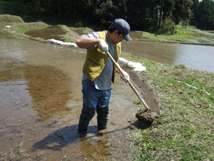
(Photo courtesy of Iio Jozo)
Keeping away insects has been equally challenging. Producing a thin film of oil on the surface of the paddy water with used tempura oil collected from restaurants proved largely successful in suffocating the rice water weevil. To prevent disease, meanwhile, the company sprinkles its own agricultural vinegar, called Biotop, diluted 300 to 1,000 times.
In addition to pesticide-free cultivation, Iio Jozo also insists on planting the rice seedlings by hand. Rice planters first came to into use in 1954, and seedling production was modified to meet the needs of mechanical planting. The planters called for seedlings of uniform size, which could not be achieved in outdoor nurseries. Nursery cabinets were then developed so that the seeds could be made to germinate simultaneously. Small seedlings came to planted, moreover, to prevent the root injury that could occur with larger seedlings when the planters rip them off the seedbed. But as the planting density cannot be adjusted at will with mechanical planting, Iio Jozo plants the seedlings by hand.
Another merit of planting by hand is that the seedlings take root faster than with mechanical planting. Fifty years since the introduction of mechanical planters, manual planting is being appreciated in a new light.
Preserving Rice Terraces
Economically based undertakings like Iio Jozo's case, in which the manufacturer aspires to sustainable agriculture and production by valuing its ties with local farmers and specifically using rice grown in rice terraces, are rare.
Meanwhile, an effort to conserve rice terraces and their natural surroundings was launched in 1995 in the form of the National Rice Terrace Liaison Council, which links municipalities having rice terraces, various organizations, and individuals through the common interest of rice terraces. One of the council's activities is organizing the annual Tanada Summit. First held in Kochi Prefecture, the fifteenth summit will be take place in 2009.
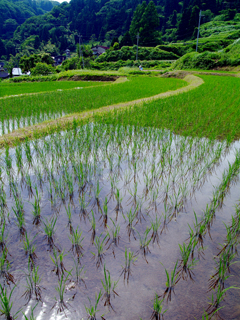
(Photo by Hiroaki Horiguchi)
Today there is a spreading movement known as the tanada owner system, in which nonfarmers pay membership fees to "own" rice terraces, participate in rice production, and receive a share of the harvest. This was started around 1990 in several municipalities including Yusuharacho, Kochi Prefecture, where the first Tanada Summit was held. Now practiced across Japan, the program defines the tanada landscape as an important regional resource and aims to preserve it while utilizing it as the focus of interaction between urban and rural dwellers.
The higher the rate of owner participation in agricultural tasks, which naturally translates to more frequent visits, the more active interaction there is between the owners and local residents. In addition to their role in rice production and land conservation, the picturesque rice terraces have the potential of developing as an attractive site of green tourism where urban dwellers can interact with local communities.
